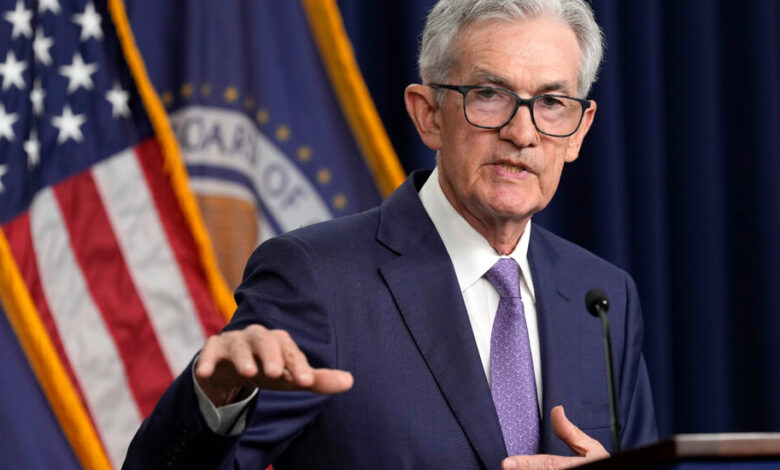Why Investors Don’t Believe the Fed

The markets and Fed diverge again
The bull market rally is continuing to run on Thursday. The S&P 500 is poised to set yet another record, as investors see inflation in retreat — even if Fed policymakers don’t quite see it that way.
The gulf between investors and the central bank is widening again. After Wednesday’s tepid Consumer Price Index report, the odds in the futures market have risen for two interest rate cuts this year, a prospect that has triggered a stocks-and-bonds buying spree.
Not so fast? The Fed’s “dot plot” projection released Wednesday sees just one cut this year, down from its previous forecast of three, as policymakers worry that inflation remains above their comfort levels. That makes the Fed more hawkish than other central banks, especially those in Europe, that are expected to trim borrowing costs several times this year. The White House has largely abandoned hopes for something similar.
Jay Powell, the Fed chair, tried to tamp down expectations at Wednesday’s news conference. He reiterated that inflation remained above the central bank’s 2 percent target and that U.S. households’ spending power had diminished over the past two years. He added that a premature cut “could end up undoing a lot of the good that we’ve done.”
Market watchers aren’t buying it. Wednesday’s C.P.I. showed that consumer prices in May rose by their lowest level in three years. Given that, the Fed’s forecast for a single cut “seems like an overly gloomy view on inflation progress,” Charlie Ripley, an investment strategist at Allianz Investment Management, wrote in a client note.
Bullish sentiment is dominating the markets. The S&P 500 has climbed nearly 14 percent this year, far outperforming what Wall Street analysts had expected at the start of 2024, even as more companies are reporting a slowdown in consumer spending.
Here are economists’ big takeaways from Wednesday’s C.P.I. and Fed reports:
-
A positive sign was that the headline C.P.I. rose by 3.3 percent on an annualized basis, although it was flat on a monthly basis. Easing gas, auto and airfare inflation helped.
-
More concerning was that housing costs were up 0.4 percent on a monthly basis, again defying analysts’ expectations for some relief for households.
-
Further out: While the latest Fed forecast sees fewer cuts this year, it sees four next year. It also sees the prime lending rate falling to about 2.8 percent by the end of 2026, down from 5.25 percent to 5.5 percent today.
HERE’S WHAT’S HAPPENING
Elon Musk predicts Tesla shareholders will approve his pay package. The electric carmaker’s chief posted to X last night what he said was data showing that investors voted overwhelmingly to re-ratify a multibillion-dollar compensation plan he was granted in 2018. (Many of the company’s biggest shareholders, including Vanguard and BlackRock, voted in favor, DealBook hears.) That result would represent a big show of investor confidence in Musk as the company’s C.E.O.; Tesla is set to announce preliminary vote results at its annual meeting today.
The U.S. imposes new punishments on Moscow as the Group of 7 convenes. The White House announced a series of sanctions aimed at disrupting Russia’s tech links with China that officials say are bolstering Vladimir Putin’s war machine. G7 leaders are also close to agreeing on a $50 billion aid package for Ukraine that would be financed with profit generated by seized Russian assets, Bloomberg reports.
Terraform Labs reaches a settlement with the S.E.C. The failed crypto trading company agreed to pay $4.47 billion to resolve the regulator’s lawsuit over its 2022 collapse, which rattled the market for digital currencies. The settlement requires Terraform to wind down its business and file for bankruptcy protection.
The world will see a glut of oil this decade, an energy watchdog forecasts. Brent crude, the global benchmark, fell Thursday on a report by the International Energy Agency predicting that demand will peak by 2029. That, coupled with an ongoing surplus of petroleum, “could usher in a lower oil price environment,” the agency said.
Vying for the C.E.O. vote
As the presidential race heats up, President Biden and Donald Trump are competing for an important constituency: corporate chieftains.
Both camps will make their cases with the C.E.O.s of top U.S. companies today: Trump and Jeff Zients, the White House chief of staff, will each speak in Washington to the Business Roundtable, one of the most influential corporate advocacy groups. Attendees are set to include Jamie Dimon of JPMorgan Chase, Brian Moynihan of Bank of America and Jane Fraser of Citigroup.
Meanwhile, Treasury Secretary Janet Yellen is addressing the Economic Club of New York. (Biden is in Italy for the Group of 7 summit meeting.)
Trump is promising deregulation and lower corporate taxes. At the Business Roundtable meeting, the former president will focus on “policies to save America,” including cutting taxes “to bring back the booming economy” of his first term, a senior campaign official told DealBook.
Trump has been embracing industries he once shunned, like crypto, while pledging a more company-friendly administration. He has won back support from some who repudiated him after the Jan. 6 riot on the Capitol, like Doug Leone of the venture capital firm Sequoia Capital. He’s also gained backers such as the tech investor David Sacks, who sat out 2020 and supported Democrat Hillary Clinton in 2016.
Biden is emphasizing a robust economy and his industrial policy. Supporters like Blair Effron, a founder of the investment bank Centerview Partners, point to growing G.D.P., low unemployment, a boom in public-private partnerships — in short, what he called “an economy that’s the envy of the world.” Effron told DealBook, “I’m perplexed that the president doesn’t get more credit for a good economy.”
Still, Biden’s plans to raise corporate taxes are a sore point for some executives. But critics of Trump say this misses the bigger picture: Roger Hochschild, a former C.E.O. of Discover Financial Services who also worked for President George H.W. Bush, pointed to Trump potentially limiting the Fed’s independence and promising favorable policies in exchange for donations as possible causes of political volatility.
“Business thrives in a predictable environment,” Hochschild told DealBook. “If there’s chaos, a lower tax rate won’t matter.”
Could Europe’s far right sink the E.U.’s green ambitions?
The bombshell results from the European Parliament elections could threaten pieces of the European Union’s trillion-euro Green Deal, the bloc’s environmental policy that has attracted a global wave of climate-conscious investors.
As political factions rush to respond, climate financing has become something of a rallying cry against the rise of Europe’s nationalist far-right, Vivienne Walt reports for DealBook.
“The far right tells us we have to choose between the environment and the economy,” President Emmanuel Macron of France said on Wednesday, adding that his political rivals were jettisoning “everything that makes the country attractive, the capacity to keep investors.”
Expect the Green Deal to survive, analysts told DealBook. The question is whether the volatility will diminish Europe’s status with E.S.G. investors, those who invest based on environmental, social and governance principles. U.S. fund managers have seen an exodus in recent quarters as investors tire of red-state boycotts, greenwashing concerns and boardroom debates that have tarnished the sector.
Europe hasn’t faced that kind of heat. But analysts at RBC Capital Markets warned clients recently that political uncertainties have become a headwind.
E.S.G. in Europe faces another threat. Companies with significant business in the E.U. must make extensive disclosures about their businesses’ environmental impact. The new power dynamics in Brussels may water down those rules — or eliminate them altogether, analysts warn.
That could create headaches for E.S.G. fund managers who’ve sold investors on Europe’s more stringent climate targets. “Even before the elections we were already seeing that these policies were having a harder time making it across the finish line,” Sara Mahaffy, an analyst at RBC Capital Markets, wrote in a research note this week.
The war in Ukraine may also take a toll. The E.U. has vowed to increase military spending in the wake of Russia’s full-scale invasion of Ukraine. That commitment could elbow aside other priorities, Hortense Bioy, head of sustainable investing research at Morningstar, told DealBook.
A big bet on big air
As traditional TV dies a slow death, live sports are the last bastion of appointment viewing. That has investors drawing up plans to build new leagues around everything from electronic sports to three-on-three basketball.
The latest example is a little extreme (or perhaps more fittingly, “X-treme”): The X Games, a kind of Olympics for daring snow and skating sports, is planning to create and sell eight teams to investors later this year, The Times’s Ben Mullin is the first to report for DealBook.
The X Games is expecting a $100 million cash infusion, including revenue from the sale of the teams and backing from the private equity firm MSP Sports Capital, which spent about $50 million to purchase the competition from ESPN in 2022.
Jeff Moorad, the C.E.O. of MSP Sports Capital, declined to provide financial details on the valuation of individual teams. But he said that X Games was already in discussions with potential investors.
MSP Sports Capital wants to capitalize on the competition’s cachet. Founded in the ’90s at the height of the skateboarding boom, X Games became synonymous with a cultural movement that gave rise to stars including the skateboarder Tony Hawk and the snowboarder Shaun White, and came with its own video games, footwear and pop-punk soundtrack.
Moorad thinks that legacy — as well as a broadcast deal with ESPN and a limited number of teams — will make the teams a hot commodity.
The new model takes its cues from the exploding popularity of Formula 1, the motor sport that now draws obsessed fans to races in Miami, Monaco, Saudi Arabia and China. The sport hosts competitions between both individual drivers and teams, each with their own fans and sponsors, allowing it to capitalize on stars like Max Verstappen. F1 teams are worth at least hundreds of millions of dollars each.
Can this work for other sports? Electronic sports, which applied the league model to competitive video games, have failed to live up to lofty market projections in recent years, and team valuations have cratered.
Moorad, who was previously the C.E.O. of the Arizona Diamondbacks M.L.B. team, isn’t worried. “Dozens of X Games athletes also compete in the Olympics,” Moorad said. “These are very different propositions.”
THE SPEED READ
Deals
-
Neither Apple nor OpenAI is reportedly receiving money as part of their new partnership, in which ChatGPT will be integrated into iPhones, iPads and Macs — at least, not yet. (Bloomberg)
-
Sony Pictures Entertainment agreed to buy Alamo Drafthouse Cinema, marking a rare instance of a Hollywood studio owning a movie theater chain. (NYT)
Elections, politics and policy
-
The Business Roundtable plans to spend “eight figures” to lobby for lower corporate taxes. (Semafor)
-
Disney and Gov. Ron DeSantis of Florida have ended their feud, giving the entertainment giant the green light to proceed with a $17 billion development plan near Orlando. (NYT)
Best of the rest
-
Eight former employees of SpaceX sued the rocket company and Elon Musk, contending they were fired for raising concerns about sexual harassment and discrimination at the workplace. (NYT)
-
“Saudi Arabia’s Next Billion-Dollar Sports Play: A Boxing Takeover” (NYT)
-
Jerry West, the Hall of Fame N.B.A. player turned Los Angeles Lakers executive — and literal icon of the league — died Wednesday. He was 86. (NYT)
We’d like your feedback! Please email thoughts and suggestions to dealbook@nytimes.com.



